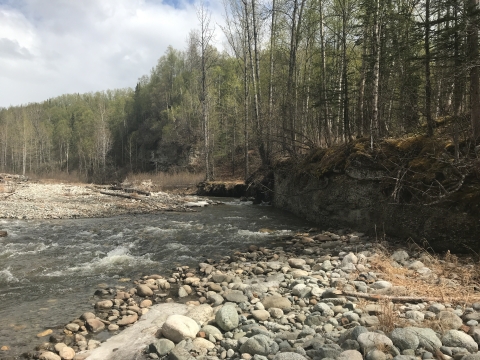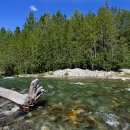States
AlaskaChickaloon Native Village, an Ahtna Tribe, is working to restore natural hydrologic and ecological function throughout the Moose Creek watershed. Moose Creek is a culturally important anadromous stream that was negatively impacted by mines and a railroad in the early 1900s. This project will design in-stream and floodplain salmon habitat restoration for up to five miles of upper Moose Creek; implement phase one of upper Moose Creek habitat restoration to remove in-stream velocity barriers in up to one mile of Moose Creek; and replace three barrier culverts and restore fish passage fish passage
Fish passage is the ability of fish or other aquatic species to move freely throughout their life to find food, reproduce, and complete their natural migration cycles. Millions of barriers to fish passage across the country are fragmenting habitat and leading to species declines. The U.S. Fish and Wildlife Service's National Fish Passage Program is working to reconnect watersheds to benefit both wildlife and people.
Learn more about fish passage on three upper Moose Creek tributaries. This project will restore fish access to 28 miles of salmon spawning and rearing habitats and will restore floodplain connectivity for approximately 1,536 acres.
Project Quick Facts:
| Location | Alaska |
| NFPP Project Funding | $3,000,000 |
| Restoration Techniques | Design, Culvert Replacement |
| Partner Project Lead | Chickaloon Village Traditional Council |
The National Fish Passage Program combines technical expertise with a track record of success.
Implemented primarily through the Service's Fish and Wildlife Conservation Offices, the National Fish Passage Program provides financial and technical assistance to partners across the country. Since 1999, the program has worked with over 2,000 local communities, Tribes, and private landowners to remove or bypass over 3,400 barriers to fish passage and reopen access to over 61,000 miles of upstream habitat for fish and other animals. Staff have expertise in fish migration and biology as well as financial, engineering, and planning assistance to communities, Tribes, and landowners to help them remove barriers and restore rivers for the benefit both fish and people.
Fish passage project proposals can be initiated by any individual, organization, government, or agency. However, proposals must be submitted and completed in cooperation with a Fish and Wildlife Conservation Office. (Please note that fish passage projects being used for federal or state compensatory mitigation or required by existing federal or state regulatory programs are not eligible for funding through the National Fish Passage Program.)
CONTACT A FISH PASSAGE COORDINATOR IN YOUR AREA TO GET STARTED.




